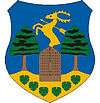Kiskőrös
| Kiskőrös | ||
|---|---|---|
|
Aerial view | ||
| ||
 Kiskőrös Location of Kiskőrös | ||
| Coordinates: 46°37′13″N 19°17′02″E / 46.62038°N 19.28381°E | ||
| Country |
| |
| County | Bács-Kiskun | |
| Area | ||
| • Total | 102.23 km2 (39.47 sq mi) | |
| Population (2009) | ||
| • Total | 14,452 | |
| • Density | 143.3/km2 (371/sq mi) | |
| Time zone | CET (UTC+1) | |
| • Summer (DST) | CEST (UTC+2) | |
| Postal code | 6200 | |
| Area code(s) | 78 | |
| Website | http://www.kiskoros.hu/ | |
Kiskőrös (Slovak: Malý Kereš / Kiškereš, Yiddish: קישקעריש Kishkerish, German: Körösch, Croatian: Kireš;[1]) is a town in Bács-Kiskun, Hungary. It is located at around 46°37′14″N 19°17′19″E / 46.62056°N 19.28861°E. Sándor Petőfi, the national poet of Hungary, was born here.
Geography
Kiskőrös is the sixth biggest city in Bács-Kiskun county by population. It is located in the center of the county, 22 kilometres (14 miles) east from the river Danube and 110 km (68 mi) south of Budapest. About 2–3 km (1–2 mi) north of the town lies the nature reserve area (since 1974) of Szücsi Forest as part of the Kiskunság National Park. The flora includes close to 300 protected plant species, one of them a special species of orchid, which blossoms here in April. Moreoever, there are 98 registered, protected bird species. Many of them are songbirds that coexist with birds of prey like kestrels, sparrow-hawks and hobbies.
Climate
Kiskőrös has a continental climate combined with a high number of yearly sunlight. The hours of annual sunlight is over 2,000 hours.
History
Kiskőrös has been populated since the late Iron Age. In the first century Transdanubia was invaded by the Romans and its population ran away and settled in the area. In the 1930s five Avar villages and seven cemeteries have been discovered. The first written documents mentioning Kiskõrös date back to 1398. By 1433 Kõrös was an independent town. The peaceful life of the town came to an end in the 16th century when the Turkish army occupied the region. A letter was written on April 11, 1529 by Mihály Pósa warning the bishop of Kalocsa about the attacks of the Turks. The town lost much of its population during the occupation. The rebirth of Kiskõrös is the work of the Wattay family. For their contribution to defeat the Turks, Leopold I gave the family the land and the surrounding areas. On May 19, 1718 700 Slovak farmers moved to Kiskõrös. The population has reached 5,000 by 1785. On January 1, 1823 Sándor Petőfi was born in Kiskõrös. In the 20th century Hungary lost both world wars and during the years of the Great Depression the economy of the village suffered greatly. Kiskõrös was occupied by the Soviet Army in 1944. After World War II, most of the income came from agriculture (wine and fruit production). Kiskőrös began to develop rapidly in the 1970s and infrastructure, educational, healthcare and welfare institutions were built. Kiskõrös became a town again in 1973.
Demographics
Kiskőrös had 15,348 residents in 2001. The population is homogeneous with a Hungarian majority. (95.8% Magyars, 3.1% Slovaks, 1.4% Romani, 0.7% Germans etc.). The distribution of religions were: 46.4% Lutheran, 27.5% Roman Catholic, 4.5% Calvinist etc.).[2]
Personalities
- Sándor Petőfi, Hungarian national poet
Buildings and structures
East of Kiskörös, there is a 150 metres (490 ft) tall concrete tower used for FM radio and television broadcasting.
Twin towns – Sister cities
The city is twinned with eight cities:[3]
 Tarnów, Poland
Tarnów, Poland Liptovský Mikuláš, Slovakia
Liptovský Mikuláš, Slovakia Naszvad, Slovakia
Naszvad, Slovakia Marghita, Romania
Marghita, Romania Stadtlengsfeld, Germany
Stadtlengsfeld, Germany Krimpen aan den IJssel, Netherlands
Krimpen aan den IJssel, Netherlands Lapua, Finland
Lapua, Finland Zhenjiang, China
Zhenjiang, China
Gallery
References
- ↑ (Croatian) "Folia onomastica croatica 14/2005.". (462 KB) Živko Mandić: Hrvatska imena naseljenih mjesta u Madžarskoj,
- ↑ Gazetteer of Hungary 2009 (Hungarian)
- ↑ "Testvértelepülések". Retrieved 30 April 2014.
Coordinates: 46°37′13″N 19°17′02″E / 46.62028°N 19.28389°E




